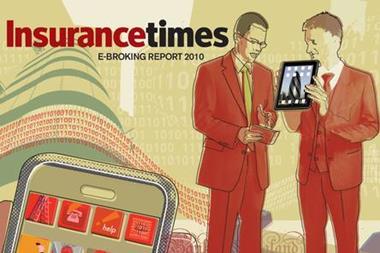Ignore the rise of the mobile phone app at your peril. It may be early days, but you need to be ready to pounce when the technology is right for your business
Mobile apps are one of the new clutch of technologies revolutionising the way that many sectors work. Analyst firm Forrester Research estimates that social media marketing is growing by about 34% a year, double the average growth rate of most online media. And as smart phone use continues to climb, no business can afford to ignore them.
Applications can be branded and customised, freeing brokers from having to build their own. They can be integrated with existing systems – as long as those systems are web-enabled – which means that a decent smart phone app could become part of a formidable social media package.
Stephen Korow is vice-president of technology at Decision Research Corporation, which has just launched an iPhone app for the insurance industry. He admits that consumer demand is low at present but sees demand increasing as insurers become aware of what the new systems offer for interacting with policyholders – particularly in claims handling.
Greater reach
“A message across multiple channels will have far greater reach as audiences become more segmented,” he says. “Ignoring the mobile phone segment ignores many potential customers, and makes the job of maintaining market share that much more difficult,” he says.
The potential is certainly there. Smart phones are aware of their user’s location, so could input data using GPS technology. For instance, a camera could capture a car number plate; recognition technology could then upload that information or provide evidence in a claim.
But buying an insurance policy is not the same as signing up to Twitter: it’s a complex process and making it work well on a mobile phone will take a little longer.
BGL managing director of claims, Martin Overton, says the move into insurance apps is “good news”; his company, for instance, is focusing heavily on the online market as customers become more comfortable paying for policies online.
But there are issues with using mobile applications for claims handling – not least the inability to detect fraud and the complexity of the process.
“It requires an in-depth knowledge of the policy and knowledge of insurance and personal injury law,” he says. “Quite often the customer perception of their claim will change as a consequence of talking to someone who understands it. If it’s all managed via an app, you may struggle with the accuracy of the data coming through and customer dissatisfaction is likely.”
Any app also will need built-in triggers capable of detecting fraudulent claims – just as staff are currently trained to detect suspect words or situations.
Overton says that many of the apps on the market now are “quite weak” as they involve little more than the downloading of forms. “They’re either not providing enough information to enable the claim to be processed, or are so detailed that you wouldn’t want to be on an iPhone doing it. It’s all relatively expensive, but only saves about 30 to 60 seconds. Customers are not demanding or expecting it right now.”
Ask what works
One obvious compromise is to use an app to simply log a claim. AXA managing director of claims David Williams says his company does this, insisting that it’s a lot cheaper to register a claim via a mobile app than it is through phone or paper forms.
He says each part of the insurance market needs to think about how their customers might use the technology – and how useful it might be. “Customers use smart phones to communicate in every other part of their lives, so why not insurance? Rather than one-size-fits-all, it’s a case of looking at the needs of the customer and asking what works.”
Korow says that as the technology develops, increasingly complicated risks could be handled via mobile internet.
“Specific risk information can be mashed up with focused data available through complimentary web services … a much clearer understanding of the risk being underwritten can be developed. If additional information or detail is required by an underwriter, images can easily be transmitted to them.”
Bluefin head of marketing Peter Elliott says that no app has caught his eye yet. “In the high net worth market, policyholders paying significant premiums value the personal advice and professional service that a broker provides – especially if a claim becomes problematic.
“But we do have to do our best to communicate with customers in the way that they want to be communicated with. Brokers have to be very flexible and respond to the requirements of their customers.”
The best approach, Korow says, is to keep a sharp eye on the development of the technology and the market, and to be ready to enter the fray.
“As the utility and value increases and other complimentary services are merged – such as finding the closest affiliated towing company or calling a cab – these applications will be relied on more and more.” IT
Hosted by comedian and actor Tom Allen, 34 Gold, 23 Silver and 22 Bronze awards were handed out across an amazing 34 categories recognising brilliance and innovation right across the breadth of UK general insurance.













































No comments yet